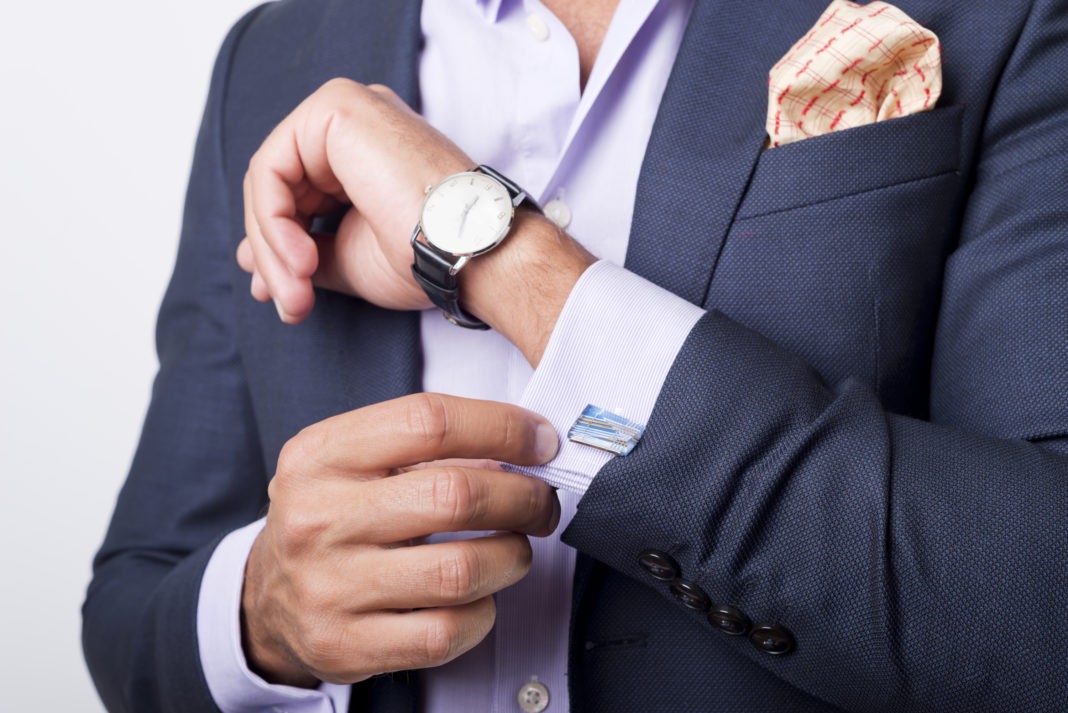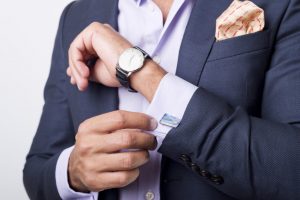
There are typically four types of corporate dress codes: business formal, business professional, business casual, and casual. Here are some general tips for both men and women for each category. Stick close to the basics and ensure that you’re always dressed appropriately.
1. Business Formal

If you work in law, regularly meet with executives, or otherwise hold a high-level position, you might be asked to come dressed “business formal” or in “boardroom attire.” This is the highest level of professional dress.
For Men:
- A tailored one-, two-, or three-button suit in a solid, neutral color like black, gray, or navy.
- Ties and other accessories should be both modest in color and style – solid, brighter colors (a red tie, for example), or patterned muted neutrals (a navy plaid tie) – as well as high-end in quality. No novelty ties, such as sports team patterns.
- White, collared button-up shirts.
- Shoes should be closed-toe oxfords in brown or black, not loafers.
- Hair should be well-groomed. In general, short hair is most acceptable. Check with HR to see if tied-back long hair is also acceptable.
- Nails should be clipped short, clean, and buffed. Don’t be shy about getting regular professional manicures.
For Women:
- A well-cut pantsuit or skirt suit in a conservative neutral color, such as black, navy, or brown.
- White button-ups with a collar.
- Closed-toe heels in a neutral color such as taupe, black, grey, or brown.
- Tights, preferably in a dark color.
- Conservative accessories – for instance, diamond studs rather than chandelier earrings.
- Well-groomed hair worn in a conservative cut, such as a bob or soft layers.
- Skirts never more than two finger-widths above the knees.
- Well-groomed, neutral nails that are either clear coated, or painted with a beige-toned polish.
2. Business Professional

A step down from business formal, business professional clothing is still neat, conservative, and traditional, if a little more loose when it comes to color or pattern. Business professional is also sometimes called “traditional business.” Expect to present a professional appearance everyday, injecting personality into your outfits with your accessories and color choices.
For Men:
- A one- or two-button suit. Suit colors should still be conservative, but you have more leeway with pattern – a conservative stripe or check, for instance.
- Pressed, lighter-colored dress pants worn with a sports jacket.
- Conservative ties, but feel free to introduce colors and patterns. For example, you can feel free to wear a blue-striped, professional tie, but no novelty ties.
- High-end accessories, such as watches (preferably silver, gold, or white gold) and cuff links, if necessary.
- Shirts should be collared button-ups, but can be colored, as long as the color is fairly conservative. Blue, burgundy, or gray all work well.
- Shoes should be conservatively colored oxfords or polished loafers in black or brown.
- Hair and nails should be groomed, but check with HR on acceptable hairstyles.
For Women:
- A suit or skirt, top, and jacket in a conservative neutral color, such as black, brown, or navy.
- Collared button-up shirts that may be any solid color.
- Dark or nude-colored hosiery.
- Closed-toe pumps in a neutral color such as black or brown.
- Larger, more noticeable jewelry – as long as it’s not distracting. Think along the lines of one statement necklace or a chunky watch. High quality is preferred.
- Skirts never more than two finger-widths above the knees.
- Well-groomed, neutral nails. May be clear coat or beige.
- Hair should be neat and groomed, but check with HR on acceptable cuts and colors.
3. Business Casual

Business casual is one of the more common dress codes in North America, allowing employees to add personality to their workwear without looking unprofessional. In a business casual setting, you can expect a lot more in the way of color and accessories.
Still, the term “business casual” can mean different things to different organizations, so it’s always best to check for guidelines with HR instead of making assumptions. Note that sometimes business casual can also be called “executive casual.”
For Men:
- Can wear colored, collared button-ups in any color. Conservative patterns such as checks or stripes are acceptable too, worn with or without a tie.
- Ties should still be conservative in pattern. Avoid novelty ties, and choose patterns like dots, stripes, or checks. Most colors are acceptable.
- Pullovers and sweaters worn over collared shirt. Choose solid, striped, or another conservatively patterned sweater. Primary and jewel-toned colors are best.
- Dressy slacks, such as black dress pants or pressed khakis in the summer, worn with or without a sports jacket.
- More casual accessories, such as a leather-band watch.
- Shoes can be oxfords, loafers, or another comfortable yet dressy choice, in brown or black. Avoid sneakers.
- May offer more leeway for hairstyles, allowing for longer hair (check with HR).
- Nails should be clean and short.
For Women:
- Business separates, rather than a full suit – a skirt worn with a cardigan or jacket, for example.
- Colored shirts and blouses, rather than mandatory collared button-downs. Choose solid colors, or muted patterns like stripes or checks, and avoid low-cut shirts or bright patterns.
- Slacks and khakis.
- Larger jewelry, such as a statement necklace or large cuff-style watch. Doesn’t necessarily need to be the highest quality – gemstones and other casual materials are fine. Scarves may also be appropriate.
- Shoes may be comfortable flats and loafers, as well as pumps, but should remain closed-toe. Can be any color, although black, brown, red, navy, and gray are among the most appropriate.
- Nails should be well-groomed, but there can be a few restrictions on colors.
- Hair can be more casual, with less conservative colors and even more noticeable (chunky or high-contrast) highlights generally acceptable. It should still be neatly styled, such as blow-dried, or in a ponytail or bun.
4. Casual

If you’re fortunate enough to work in a casual office, the trick is to avoid getting too casual or creative with your dress. According to the survey by Salary.com, your coworkers make specific judgements regarding your capability based on your clothes, which may extend to employers as well. By arriving to work in casual clothes that are still neat, pressed, and appropriate for the type of work you do, you can make sure that a casual dress code isn’t holding you back.
For Men:
- Casual pants and slacks, but never jeans unless stipulated as acceptable by HR. If jeans are permitted, dark-wash, straight-cut only.
- Collared polos or crew-neck sweaters and pullovers. The majority of colors and patterns are okay as long as they’re not a novelty pattern, such as a sports team logo.
- Casual accessories, such as brightly colored watches.
- Shoes that are clean. Sneakers are usually acceptable, as are loafers.
- Hair and nails can be more casual. Nails should remain short and clean, and casual offices generally allow for longer hairstyles and ponytails.
For Women:
- Nicely fitted tops and blouses, although shirts should never be tight or revealing.
- Slacks or skirts in more casual fabrics, such as cotton. If denim is permitted, dark-wash only. Avoid overly casual denim cuts, like cutoffs or flare jeans.
- Skirts should remain at knee-length.
- Open-toed shoes are permitted. Avoid casual shoes such as sneakers or flip-flops.
- Casual accessories, such as scarves. Larger rings, bracelets, earrings, and necklaces are fine, and may be of any quality.
- More leeway with hair length, style, and color. More adventurous styles and colors are typically fine.
- Nails can be painted in brighter colors, or with any type of pattern. Avoid novelty characters or designs, or limit “louder” designs to one nail only.
What About Tattoos?
Tattoos and piercings in the workplace can affect you across all dress codes. Hopefully, any facial piercings (besides women’s ears) can be removed for professional wear, and tattoos can be easily hidden.
Unless you’re working in a casual office, or otherwise stated by HR, tattoos are typically best concealed during working hours. Try some of these tricks:
- Wear pants to cover leg tattoos.
- When wearing skirts, women should choose dark-colored opaque hose to cover leg tattoos.
- Men should wear shirts that adequately cover ink.
- Use accessories to strategically conceal tattoos, such as scarves for neck tattoos, or large watches to hide small wrist tattoos.
- When in doubt, be upfront with HR. Let them know if you have tattoos and ask for their policy on tattoos and piercings so you’re perfectly clear on what is and isn’t appropriate.

Final Word
Basic tips are the name of the game for deciphering corporate dress code, if only for the reason that your office might interpret “business casual” differently than another organization. In office dress codes, it’s always best to err on the side of caution and dress a little more formally than necessary until you have a better grasp of what is and isn’t acceptable at work. If your business clothing mantra is “clean, tailored, and professional,” it’s pretty hard to go wrong, regardless of the environment in which you work.
What type of dress code does your office use?

